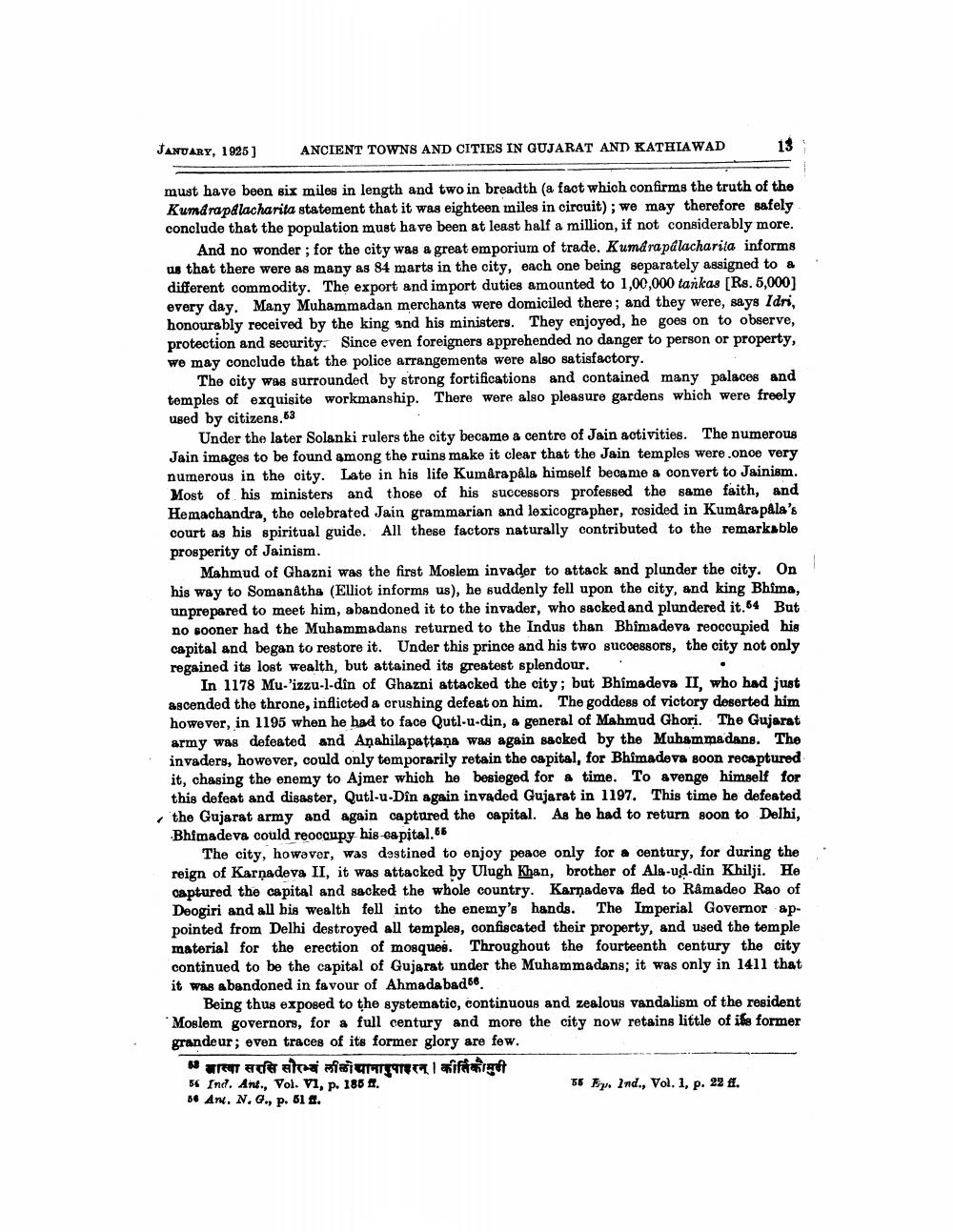________________
JANUARY, 1925)
ANCIENT TOWNS AND CITIES IN GUJARAT AND KATHIAWAD
13
must have been six miles in length and two in breadth (a fact which confirms the truth of the Kumarapalacharita statement that it was eighteen miles in circuit) ; we may therefore safely conclude that the population must have been at least half a million, if not considerably more.
And no wonder ; for the city was a great emporium of trade. Kumdrapálacharita informs us that there were as many as 84 marts in the city, each one being separately assigned to a different commodity. The export and import duties amounted to 1,00,000 tankas (Rs. 5,000) every day. Many Muhammadan merchants were domiciled there; and they were, says Idri, honourably received by the king and his ministers. They enjoyed, he goes on to observe, protection and security. Since even foreigners apprehended no danger to person or property, we may conclude that the police arrangements were also satisfactory.
The city was surrounded by strong fortifications and contained many palaces and temples of exquisite workmanship. There were also pleasure gardens which were freely used by citizens.63
Under the later Solanki rulers the city became a centre of Jain activities. The numerous Jain images to be found among the ruins make it clear that the Jain temples were onoe very numerous in the city. Late in his life Kumarapala himself became a convert to Jainism. Most of his ministers and those of his successors professed the same faith, and Hemachandra, the celebrated Jain grammarian and lexicographer, rosided in Kumāra pala's court as his spiritual guide. All these factors naturally contributed to the remarkable prosperity of Jainism.
Mahmud of Ghazni was the first Moslem invader to attack and plunder the city. On his way to Somanátha (Elliot informs us), he suddenly fell upon the city, and king Bhima, unprepared to meet him, abandoned it to the invader, who sacked and plundered it.64 But no sooner had the Muhammadans returned to the Indus than Bhimadeva reoccupied his capital and began to restore it. Under this prince and his two successors, the city not only regained its lost wealth, but attained its greatest splendour.
In 1178 Mu-'izzu-l-din of Ghazni attacked the city; but Bhimadeva II, who had just ascended the throne, inflicted a crushing defeat on him. The goddess of victory deserted him however, in 1195 when he had to face Qutl-u-din, a general of Mahmud Ghori. The Gujarat army was defeated and Anahila pattana was again sacked by the Muhammadans. The invaders, however, could only temporarily retain the capital, for Bhimadeva soon recaptured it, chasing the enemy to Ajmer which he besieged for a time. To avenge himself for this defeat and disaster, Qutl-u-Din again invaded Gujarat in 1197. This time he defeated the Gujarat army and again captured the capital. As he had to return soon to Delhi, Bhimadeva could reoccupy his capital. 66
The city, howavor, was destined to enjoy peace only for a century, for during the reign of Karṇadeva II, it was attacked by Ulugh Khan, brother of Ala-ud-din Khilji. He captured the capital and sacked the whole country. Karnadeva fled to Ramadeo Rao of Deogiri and all his wealth fell into the enemy's hands. The Imperial Governor appointed from Delhi destroyed all temples, confiscated their property, and used the temple material for the erection of mosques. Throughout the fourteenth century the city continued to be the capital of Gujarat under the Muhammadans; it was only in 1411 that it was abandoned in favour of Ahmadabad66.
Being thus exposed to the systematic, continuous and zealous vandalism of the resident Moslem governors, for a full century and more the city now retains little of its former grandeur; even traces of its former glory are few.
"जात्वा सरसि सौरभ्वं लीलोयानापावरन् । कीर्तिकौमुरी 56 Ind. Ant., Vol. VI, p. 186 .
55 Ep. Ind., Vol. 1, p. 22 ff. 86 Ane, N, ., p. 61 a.




